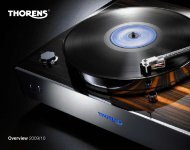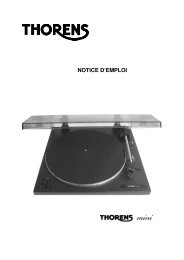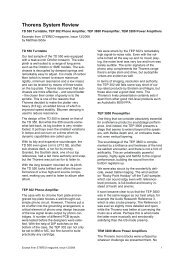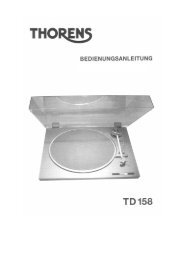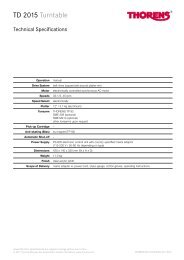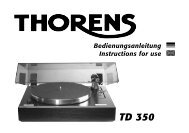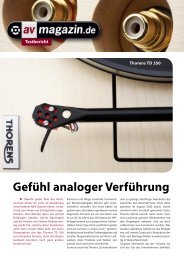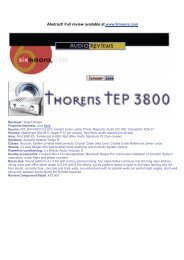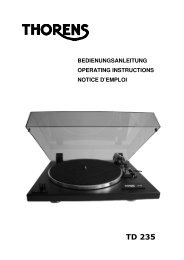Create successful ePaper yourself
Turn your PDF publications into a flip-book with our unique Google optimized e-Paper software.
REPRINT OF audioXpress VOLUME 35 ISSUE 1 January 2004<br />
<strong>Product</strong> <strong>Review</strong><br />
<strong>Thorens</strong> TD 295 MK III<br />
<strong>Review</strong>ed by Charles Hansen<br />
<strong>Thorens</strong> Export Co. Ltd., IM Junkholz 44 •<br />
CH-4303, Kaiseraugst-Basel, Switzerland,<br />
phone: ++41 (0)61 813 03 36 • FAX:<br />
++41 (0)61 813 03 39, www.thorens.ch<br />
(info@thorens.ch), $899, warranty 2<br />
years. Supplied by Trian Electronics,<br />
Inc., 5816 Highway K, Waunakee, WI<br />
53597, 608-850-3600. Dimensions:<br />
435mm W × 358mm D × 145mm H (dust<br />
cover closed), weight: 8.5kg.<br />
The TD 295 Mk III is a two-speed beltdriven<br />
turntable with a low voltage<br />
motor. The TP 42 tonearm is supplied<br />
“plug and play ready” with an Ortofon<br />
OMB 10 cartridge, and will accept any<br />
cartridge with standard ½″ mounting<br />
holes. The upper surface of the<br />
turntable base is available in three colors:<br />
black, mahogany, or anis wood, all<br />
with an elegant high-gloss multi-layer<br />
“piano” finish (Photo 1). The dust cover<br />
sits on two pivoting posts at the rear of<br />
the base.<br />
CONSTRUCTION<br />
The motor, platter, and the tonearm assembly<br />
are all solidly mounted to the<br />
upper section of the base assembly.<br />
Four sandwich layers of MDF make up<br />
the lower section of the base. The base<br />
assembly sits on four elastomer cones<br />
with felt-bottomed plastic feet.<br />
The 15cm inner platter is die-molded<br />
from a rigid but lightweight fiber material<br />
and has an integral spindle. The<br />
outer rim of the inner platter is belt driven<br />
from the motor (Photo 2). The<br />
turntable spindle sits on a robust<br />
<strong>Thorens</strong> Safeguard TM ball bearing. The<br />
30cm 2.3kg main platter is zinc alloy<br />
and is dynamically balanced. It sits on<br />
top of the inner platter and provides the<br />
mass inertia to ensure that vibrations<br />
are absorbed, and motor speed fluctuations<br />
and torque pulses are kept in<br />
check. A felt mat is provided for the<br />
platter playing surface.<br />
PHOTO 1:<br />
TD 295 MK III front view.<br />
A 15V AC 0.19A wall adapter that<br />
plugs into a 5.5mm jack on the rear of<br />
the turntable powers the 10-pole twospeed<br />
synchronous motor. The adapter<br />
feeds a built-in electronic oscillator that<br />
provides for either 33¹⁄₃ or 45 rpm operation,<br />
selected by a rotary switch on the<br />
left side of the base. A 45 rpm spindle<br />
adapter is provided. In the center stop<br />
position, the electronic controller applies<br />
dynamic braking<br />
to the motor<br />
windings to rapidly<br />
bring the turntable<br />
to a halt and hold it<br />
in position.<br />
A push-button<br />
on-off switch sits to<br />
the right of the<br />
speed selector<br />
switch. In the off<br />
mode, the motor<br />
voltage is disengaged,<br />
so you can<br />
manually rotate the<br />
turntable. An optical<br />
sensor silently<br />
shuts off the motor<br />
when the tonearm<br />
reaches the leadout<br />
grooves of a<br />
record. This optoelectronic LED sensor<br />
does not mechanically load the tonearm<br />
as would a micro-switch auto-stop<br />
sensor.<br />
TONEARM AND CARTRIDGE<br />
The TP 42 tonearm is a straight hollow<br />
metal tube with an effective length of<br />
229mm. The cartridge is mounted with<br />
a 25° offset and 18.8mm overhang. The<br />
PHOTO 2: TD 295 MK III motor and inner platter belt drive.<br />
audioXpress January 2004
tonearm is supported by two concentric<br />
gimbal needle bearings. The counterweight<br />
has an elastomer isolation insert,<br />
and threads onto the counterweight<br />
shaft for tracking force (TF) adjustments.<br />
The tonearm lift/cueing<br />
lever has a well-damped action that sets<br />
the stylus gently on the record.<br />
Anti-skating is implemented by<br />
means of a small cylindrical weight.<br />
You place its thin monofilament line in<br />
one of three notches in the anti-skating<br />
post at the rear of the tonearm. This is<br />
best done with tweezers. The weight<br />
then loops through a wire support arm<br />
that directs the monofilament line away<br />
from the tonearm and allows the weight<br />
to hang vertically above the base. Notch<br />
1 is used for the OMB 10.<br />
The tonearm is hard-wired to a 1m<br />
pair of shielded interconnects with<br />
gold-plated RCA phono connectors. An<br />
integral turntable ground wire is included<br />
to allow you to ground the TD<br />
295 MK III to your phono preamp chassis.<br />
The tonearm wiring uses litz wire<br />
from the cartridge clips to the phono interconnects.<br />
Cable capacitance is listed<br />
as 160pF.<br />
The standard Ortofon OMB 10 cartridge<br />
is pre-mounted to the tonearm,<br />
with VTA pre-adjusted at the factory.<br />
The OMB 10 has an elliptical diamond<br />
TABLE 1<br />
ORTOFON OMB 10 CARTRIDGE<br />
SPECIFICATIONS<br />
Output voltage 4mV at 5cm/s, 1kHz<br />
Channel balance 1.5dB at 1kHz<br />
Channel separation 22dB at 1kHz, 15dB at 15kHz<br />
Frequency response 20−20kHz, +3/−1dB<br />
20−24kHz, ±3dB<br />
FIM distortion 70dB, DIN 45-539-B
soundstage was wide and stable.<br />
After my extended playing interval,<br />
the AC adapter transformer was only<br />
slightly warm to the touch.<br />
MEASUREMENTS<br />
I used two test records: Stereo <strong>Review</strong>’s<br />
SR12 Stereo Test Record (1969) and Hi-<br />
Fi News & Record <strong>Review</strong>’s Test Record<br />
(HFN-001, 1996). I used the DacT CT 100<br />
phono preamp for measurements due<br />
to its versatile cartridge load switching<br />
and selectable EQ time constants. I set<br />
the CT 100 for 47kΩ/200pF load and flat<br />
(3-point) RIAA response.<br />
The frequency response for the TD<br />
295 MK III is shown in Fig. 1, measured<br />
at the CT 100 phono preamp output<br />
jacks. I established 0dBr as 400mV preamp<br />
output using the 1kHz reference<br />
track on the SR12 test record. The overall<br />
response was determined by measuring<br />
the output voltage for the 19 warble<br />
tracks covering 20kHz down to 20Hz.<br />
HF response rose at each end of the<br />
audio spectrum, but remained within<br />
the +3/−1dB specification for the OMB<br />
10. The DacT CT 100 has an optional<br />
3.18µs (50kHz) rolloff time constant<br />
FIGURE 1: Frequency response.<br />
V<br />
0.5<br />
0.4<br />
0.3<br />
0.2<br />
0.1<br />
0.0<br />
-0.1<br />
-0.2<br />
-0.3<br />
-0.4<br />
-0.5<br />
0.0 0.2 0.4 0.6 0.8 1.0 1.2 1.4 1.6 1.8<br />
ms<br />
2.0<br />
<strong>Thorens</strong> TD 295 Mk III<br />
FIGURE 2: 1kHz square wave response.<br />
switch that would level off the HF response.<br />
This time constant is standard<br />
in the Hagerman Bugle.<br />
Channel separation for the six test<br />
tracks is shown in Table 2. Results were<br />
essentially the same for the R-L and L-R<br />
tests. Ortofon specifies −22dB for the<br />
OMB 10 at 1kHz.<br />
My LED strobe showed both platter<br />
speeds to be absolutely spot-on. The results<br />
were the same whether a record<br />
was being played or not. While the<br />
motor does take several revolutions to<br />
overcome the platter inertia, once at<br />
speed there is no movement of the bars<br />
on the strobe disk to indicate any flutter<br />
or wow. The strobe emits very narrow<br />
light pulses that are synchronized<br />
to the 60Hz power line.<br />
I measured the frequency of three<br />
reference frequency tracks on the test<br />
record. The 440Hz “A” measured<br />
440Hz, the 1kHz track measured 989Hz,<br />
and the 3kHz track measured 2968Hz.<br />
The latter two tracks are only 1.1%<br />
below the specified frequencies if the<br />
test record tracks were done perfectly.<br />
The inner platter and motor pulley diameters<br />
have about a 6.86:1 ratio. The<br />
A-2284-1<br />
A-2284-2<br />
motor would need to turn about 229rpm<br />
for 33¹⁄₃ rpm at the platter, and 308rpm<br />
for 45rpm at the platter. For a 10-pole synchronous<br />
motor, this requires an oscillator<br />
frequency at the motor stator windings<br />
of 19Hz and 25.7Hz, respectively.<br />
I used a magnetic flux pickup<br />
placed near the motor end plate to try<br />
to determine the oscillator frequency.<br />
Using an oscilloscope, I found the flux<br />
waveform frequency to be very close to<br />
those values. The flux had a high percentage<br />
of second harmonic, indicating<br />
the stator may use two slots per<br />
rotor pole. The motor reluctance<br />
torque also produces a second harmonic<br />
component in a synchronous<br />
motor stator at near full load.<br />
When the speed select rotary switch<br />
is in the center stop position, the flux<br />
waveform appears to be 120Hz, perhaps<br />
indicating that a full-wave rectified<br />
“DC” voltage is applied to the stator<br />
windings to freeze the rotor position.<br />
The low motor frequencies allow the TD<br />
295 motor pulley to be larger than a<br />
60Hz line powered motor, providing<br />
more belt contact surface.<br />
Figure 2 shows the cartridge re-<br />
mV<br />
200<br />
160<br />
120<br />
80<br />
40<br />
0<br />
-40<br />
-80<br />
-120<br />
-160<br />
-200<br />
0 5 10 15 20 25 30 35 40 45<br />
ms<br />
50<br />
<strong>Thorens</strong> TD 295 Mk III<br />
FIGURE 3: 1kHz tone burst response.<br />
mV<br />
200<br />
160<br />
120<br />
80<br />
40<br />
0<br />
-40<br />
-80<br />
-120<br />
-160<br />
-200<br />
0.0 0.5 1.0 1.5 2.0 2.5 3.0 3.5 4.0 4.5<br />
ms<br />
5.0<br />
<strong>Thorens</strong> TD 295 Mk III<br />
FIGURE 4: 10kHz tone burst response.<br />
A-2284-3<br />
A-2284-4<br />
audioXpress January 2004
dB<br />
0<br />
-10<br />
-20<br />
-30<br />
-40<br />
-50<br />
-60<br />
-70<br />
-80<br />
-90<br />
-100<br />
0 1 2 3 4 5<br />
<strong>Thorens</strong> TD 295 Mk III<br />
FIGURE 5: Spectrum of 300Hz + 4kHz intermodulation signal.<br />
sponse to a 1kHz square wave test<br />
track. The illustration in the test record<br />
booklet shows a slight tilt and cupping<br />
in the “ideal” as-recorded waveform, so<br />
it does not represent a perfect square<br />
wave shape. I have found that this<br />
rolled off wave-shape with a slight oscillation<br />
at the leading edges is the usual<br />
performance result in my testing.<br />
Figure 3 shows the response to a<br />
1kHz tone burst. The OMB 10 achieved<br />
very accurate results here, with no evidence<br />
of response dips, resonance, or<br />
���������<br />
����������<br />
��������������<br />
������������<br />
�������������������������<br />
������������������������������<br />
�����������������������<br />
����������������������<br />
����������������������������<br />
�����������������������������<br />
�����������������������������<br />
�������������������������������<br />
�����������������������������<br />
����������������������<br />
audioXpress 1/04 www.audioXpress.com<br />
kHz<br />
A-2284-5<br />
spurious response. Figure 4 shows the<br />
exemplary response to the 10kHz tone<br />
burst track.<br />
Figure 5 shows the Ortofon OMB 10<br />
output spectrum reproducing a combined<br />
300Hz + 4kHz intermodulation<br />
distortion (IMD) signal. The 4kHz signal<br />
is recorded at 7.5cm/s (−50dB rel),<br />
and the 300Hz signal is recorded at<br />
9cm/s (−25dB rel). The 4.3kHz IMD<br />
product is −66dBr, and the 3.7kHz product<br />
is −67dBr, with no other spurious<br />
products evident. There are additional<br />
response peaks at 60Hz (−49dBr) and<br />
120Hz (−48dBr).<br />
I think these power line artifacts are<br />
due to residual hum pickup in my test<br />
setup, since I also noted them during<br />
the tests on the DacT CT 100 phono preamp.<br />
The CT 102 power supply is a highfrequency<br />
switcher, and does not bring<br />
the 60Hz line onto its power-supply<br />
board.<br />
The manufacturer’s specifications<br />
and measured results are shown in<br />
Table 3.<br />
CONCLUSION<br />
The TD 295 MK III is a substantial and<br />
stable record playing platform, with excellent<br />
speed performance and very<br />
good noise isolation. The Ortofon OMB<br />
10 cartridge is a good match for the<br />
tonearm/table combination and offers<br />
fine performance. ❖<br />
Reprinted, with permission, from audioXpress,<br />
Volume 35, Issue 1, 2004, p.p.<br />
56-59, of audioXpress magazine. © Copyright<br />
2004 by Audio Amateur Corporation.<br />
P.O. Box 876, Peterborough, NH 03458<br />
���������������������������������������������������������������������������������������������������������������������������������������������������������



